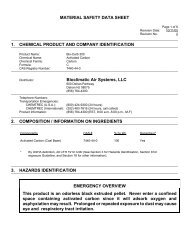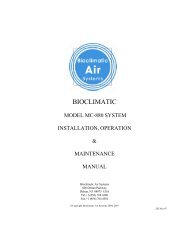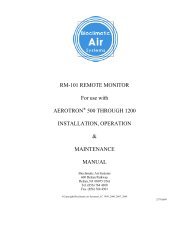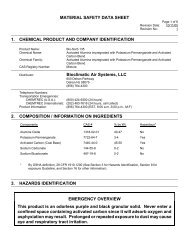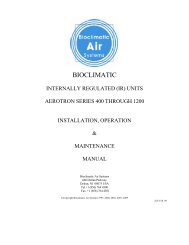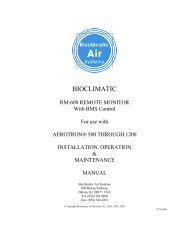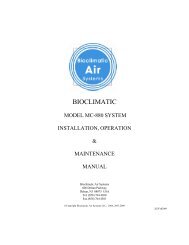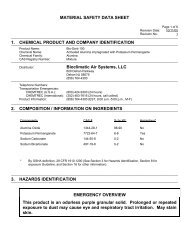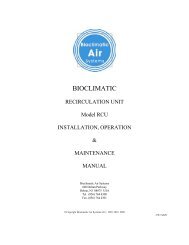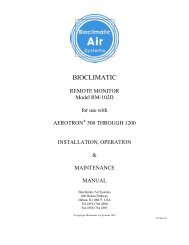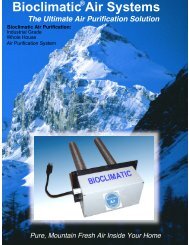Model RM-1200 w/ BMS Control - Bioclimatic
Model RM-1200 w/ BMS Control - Bioclimatic
Model RM-1200 w/ BMS Control - Bioclimatic
Create successful ePaper yourself
Turn your PDF publications into a flip-book with our unique Google optimized e-Paper software.
BIOCLIMATIC<br />
<strong>RM</strong>-<strong>1200</strong> REMOTE MONITOR<br />
With <strong>BMS</strong> <strong>Control</strong><br />
For use with<br />
AEROTRON® 500 THROUGH <strong>1200</strong><br />
INSTALLATION, OPERATION<br />
&<br />
MAINTENANCE<br />
MANUAL<br />
<strong>Bioclimatic</strong> Air Systems<br />
600 Delran Parkway<br />
Delran, NJ 08075 USA<br />
Tel. (856) 764 4300<br />
Fax (856) 764 4301<br />
©Copyright <strong>Bioclimatic</strong> Air Systems LLC 2006, 2007, 2009<br />
307/Feb09
BIOCLIMATIC<br />
<strong>RM</strong>-<strong>1200</strong> REMOTE MONITOR<br />
With <strong>BMS</strong> <strong>Control</strong> (<strong>RM</strong>-<strong>1200</strong>/<strong>BMS</strong>C)<br />
TABLE OF CONTENTS<br />
1 INTRODUCTION...............................................................................................................................................3<br />
1.1 Disclaimer...............................................................................................................................................3<br />
1.2 Receiving.................................................................................................................................................3<br />
1.3 Storage ....................................................................................................................................................3<br />
1.4 Warranty .................................................................................................................................................4<br />
2 PHYSICAL DESCRIPTION AND THEORY OF OPERATION................................................................6<br />
2.1 Principle of Operation............................................................................................................................6<br />
2.2 Front Panel <strong>Control</strong>s and Indicators ....................................................................................................7<br />
2.3 Internal Equipment and Connections…………………………………………………………………..8<br />
3 INSTALLATION ................................................................................................................................................. 8<br />
3.1 Initial Setup ............................................................................................................................................ 8<br />
3.2 Electrical Connections ........................................................................................................................... 9<br />
4 SYSTEM STARTUP............................................................................................................................................ 11<br />
4.1 Operating System Gain <strong>Control</strong> ..............................................................................................................11<br />
4.2 Setting the <strong>BMS</strong>C....................................................................................................................................12<br />
5 OPERATION & MAINTENANCE OF UNIT ................................................................................................12<br />
5.1 General ...................................................................................................................................................12<br />
5.2 Interpreting TestResults..........................................................................................................................13<br />
5.3 Troubleshooting Guide...........................................................................................................................14<br />
5.4 Troubleshooting Table ...........................................................................................................................15<br />
5.5 Ionization Tube Maintenance.......................................................................................................16<br />
.<br />
6 SPECIFICATIONS..............................................................................................................................................16<br />
6.1 Electrical.................................................................................................................................................16<br />
6.2 Mechanical..............................................................................................................................................16<br />
7 APPENDIX ...........................................................................................................................................................17<br />
A Front Panel <strong>Control</strong>s and Indicators ............................................................................................................17<br />
B Internal Equipment and Connections............................................................................................................18<br />
C Electrical Schematic.......................................................................................................................................19<br />
D Discrete Channel Fault Alarm (Option A)...................................................................................................20<br />
E Discrete Channel Fault Alarm (Option B)....................................................................................................21<br />
F Rear Side of Front Panel (door)....................................................................................................................22<br />
G Interpreting Test Results ...............................................................................................................................23
<strong>RM</strong>-<strong>1200</strong>/<strong>BMS</strong>C - I, O, & M Manual<br />
Page 3<br />
1 INTRODUCTION<br />
1.1 Disclaimer<br />
These instructions are submitted with the implicit understanding that:<br />
1.1.1 This manual is to guide the user of <strong>Bioclimatic</strong> equipment in the proper<br />
installation, operation and maintenance procedures to insure maximum<br />
equipment life with efficient operation.<br />
1.1.2 The customer has assigned competent maintenance and operating personnel<br />
to the system described herein and will assume operational and maintenance<br />
responsibility upon start-up of the system.<br />
1.1.3 The customer will read and thoroughly examine the foregoing instructions<br />
and will notify the seller of any points not fully understood, points of conflict<br />
or error.<br />
1.1.4 The customer, in lieu of any notification to the contrary, has read and fully<br />
understands the operation of the System and is aware of the hazards of<br />
corrosion, abrasion and fire or explosion and shall take the necessary steps in<br />
the operation of equipment to control such hazards to the maximum extent<br />
possible.<br />
1.1.5 Start-up assistance or field engineering service provided by <strong>Bioclimatic</strong> shall<br />
in no way relieve the customer of responsibility for the proper operation of<br />
the System.<br />
IMPORTANT: Any modifications to the unit by unauthorized personnel will void<br />
ETL listing and factory warranty. The unit must be installed in accordance with the<br />
manufacturer’s instructions to preserve warranty and ETL label.<br />
1.2 Receiving<br />
Products leaving the <strong>Bioclimatic</strong> factory are inspected and in satisfactory operating<br />
condition. All equipment should be thoroughly inspected when received. Although all units<br />
are properly packaged, rough handling in transit can cause breakage. Any shortage or<br />
damage should be reported at once to the transportation company. Note the damage on the<br />
bill of lading before signing for the shipment. Equipment MAY NOT be returned to<br />
<strong>Bioclimatic</strong> without written authorization. Returned equipment sent without<br />
authorization will be refused and returned to sender.<br />
All products are shipped F.O.B. <strong>Bioclimatic</strong> warehouse. Responsibility for all equipment<br />
passes to the Buyer at the time equipment is loaded onto the carrier's truck.<br />
1.3 Storage<br />
If the <strong>RM</strong>-<strong>1200</strong>/<strong>BMS</strong>C is not installed upon delivery, it should be stored in a cool, dry,<br />
weather protected location. Do not stack any other equipment on top of the unit.
<strong>RM</strong>-<strong>1200</strong>/<strong>BMS</strong>C - I, O, & M Manual<br />
Page 4<br />
1.4 Warranty<br />
THE SELLER WARRANTS THE EQUIPMENT AGAINST DEFECTIVE<br />
WORKMANSHIP AND MATERIAL FOR FIFTEEN (15) MONTHS FROM DATE OF<br />
FACTORY SHIPMENT OR ONE (1) YEAR FROM COMMISSIONING, WHICHEVER<br />
OCCURS FIRST. IN THE FULFILLMENT OF ITS WARRANTY, THE SOLE<br />
OBLIGATION OF SELLER SHALL BE TO REPAIR OR REPLACE, AT ITS OPTION,<br />
F.O.B. ITS FACTORY, ANY PART OR PARTS WHICH ARE RETURNED F.O.B. ITS<br />
FACTORY, SHIPPING CHARGES PREPAID, AND WHICH AFTER INSPECTION BY<br />
SELLER ARE FOUND TO BE DEFECTIVE. BUYER SHALL NOTIFY SELLER OF<br />
DEFECT IN WRITING, PROMPTLY UPON DISCOVERY AND WITHIN THE<br />
WARRANTY PERIOD. THIS WARRANTY DOES NOT COVER DEFECTS CAUSED<br />
BY CORROSION OR NO<strong>RM</strong>AL DETERIORATION; IT DOES NOT EXTEND TO<br />
CONSEQUENTIAL DAMAGE, LOSS OR DELAY ASSOCIATED WITH A<br />
WARRANTY DEFECT; AND IT DOES NOT COVER ANY COST OF LABOR,<br />
TRAVEL, OR OTHER EXPENSE ASSOCIATED WITH THE REPAIR OR<br />
REPLACEMENT OF DEFECTIVE PARTS. SELLER ASSUMES NO LIABILITY FOR<br />
PRODUCT LOSS OR OTHER CLAIMS WHATSOEVER ARISING OUT OF THE USE<br />
OR APPLICATION OF THE EQUIPMENT IN ANY OPERATIONS, WHETHER THE<br />
MACHINE IS USED ALONE OR IN CONJOINT USE WITH OTHER EQUIPMENT OR<br />
PROCESSES. NOTWITHSTANDING THE FOREGOING, SELLER'S WARRANTY<br />
OBLIGATIONS WITH RESPECT TO ANY ITEMS NOT MANUFACTURED BY<br />
SELLER SHALL NOT EXCEED THE OBLIGATIONS UNDERTAKEN BY THE<br />
MANUFACTURER THEREOF UNDER EXPRESS WARRANTY TO THE SELLER.<br />
THIS EXPRESS WARRANTY IS IN LIEU OF ALL OTHER WARRANTIES OF<br />
FITNESS OF THE MACHINE FOR ANY PARTICULAR PURPOSE.<br />
THERE ARE NO OTHER REPRESENTATIONS, WARRANTY OF CONDITION IN<br />
ANY RESPECTS EITHER EXPRESSED OR IMPLIED, STATUTORY OR<br />
OTHERWISE IN CONTRACT OR TORT, OTHER THAN WHAT IS STATED<br />
ABOVE.<br />
THE SELLER SHALL NOT BE HELD LIABLE IN ANY WAY FOR<br />
CONSEQUENTIAL DAMAGES, HOWEVER CAUSED.<br />
THIS WARRANTY WILL NOT APPLY IF THE SELLER’S EQUIPMENT HAS BEEN<br />
DAMAGED DUE TO IMPROPER INSTALLATION, ALTERATION, ABUSE OR<br />
MISUSE, ACCIDENT, FIRE, FLOOD OR ACT OF GOD. FURTHER, THIS<br />
WARRANTY WILL NOT APPLY IF REPAIRS, REPLACEMENTS, OR<br />
ALTERATIONS ARE MADE BY OTHERS WITHOUT THE SELLER’S PRIOR<br />
WRITTEN AUTHORIZATION.<br />
IN THE EVENT THE STATE IN WHICH THE EQUIPMENT IS INSTALLED DOES<br />
NOT PE<strong>RM</strong>IT THE LIMITATION OR EXCLUSION OF IMPLIED WARRANTIES<br />
OR CONDITIONS UNDER GIVEN CIRCUMSTANCES, THE PROVISIONS OF THIS<br />
WRITTEN WARRANTY ARE IN ADDITION TO AND NOT A MODIFICATION OF<br />
THE STATUTORY WARRANTIES AND OTHER RIGHTS AND REMEDIES<br />
PROVIDED BY SUCH LAWS.
<strong>RM</strong>-<strong>1200</strong>/<strong>BMS</strong>C - I, O, & M Manual<br />
Page 5<br />
NOTE:<br />
“ANY MODIFICATION TO ORIGINAL EQUIPMENT BY ANY COMPANY OR<br />
PERSON OTHER THAN THE MANUFACTURER WILL SERVE TO CANCEL AND<br />
VOID ALL OF THE SELLER’S LIABILITY UNDER THE MANUFACTURER’S<br />
WARRANTY. ENCLOSURES CONTAINING ELECTRONIC COMPONENTS ARE<br />
NO<strong>RM</strong>ALLY SEALED BY THE MANUFACTURER TO PREVENT<br />
UNAUTHORIZED TAMPERING OR ADJUSTMENTS. ONLY AUTHORIZED<br />
SERVICE PROVIDES MAY BREAK SEALS TO COMPLETE CALIBRATION OR<br />
TO TROUBLE SHOOT THE UNIT. UNAUTHORIZED TAMPERING OR<br />
BREAKING SEALS WILL RELEASE THE SELLER FROM ANY FUTURE<br />
LIABILITY UNDER THE WARRANTY”.
<strong>RM</strong>-<strong>1200</strong>/<strong>BMS</strong>C - I, O, & M Manual<br />
Page 6<br />
2 PHYSICAL DESCRIPTION AND THEORY OF OPERATION<br />
2.1 Principle of Operation<br />
2.1.1 <strong>RM</strong>-<strong>1200</strong>/<strong>BMS</strong>C<br />
The <strong>RM</strong>-<strong>1200</strong>/<strong>BMS</strong>C Remote Monitor is an electronically controlled power<br />
regulator and visual status indicator designed to operate in conjunction with<br />
multiple bi-polar ionization generators. The <strong>RM</strong>-<strong>1200</strong>/<strong>BMS</strong>C is used to<br />
simultaneously regulate the output and individually monitor the operating<br />
status of up to six (6) power generators in a system.<br />
The heart of the <strong>RM</strong>-<strong>1200</strong>/<strong>BMS</strong>C is an integrated six (6) channel electronic<br />
fault detection and alarm circuit board. This board closely monitors the<br />
ionization level of the generator by comparing a voltage derived sensing<br />
signal with a preset LED circuit. The result is real-time status monitoring of<br />
ionization voltage across all tubes in the generator.<br />
The <strong>RM</strong>-<strong>1200</strong>/<strong>BMS</strong>C Remote Monitor is an entirely self-contained unit<br />
designed for wall or surface mounting. Electronic circuitry and power<br />
regulation devices together with associated ionization level control and visual<br />
status indicators are all housed within a NEMA 1 enclosure.<br />
The <strong>RM</strong>-<strong>1200</strong>/BSMC has three operating ranges, "Under", "Normal" and<br />
"Overload". Each range is adjusted within certain limits of ionization as set<br />
by the level control on the front panel. As the ionization control is advanced<br />
(turned up), ionization increases and the status indicators will switch in<br />
sequence from Under (Amber) to Normal (Green) to Overload (Red), thus<br />
providing a visual indication of output level. Since the level control is<br />
continuously variable, system operators are free to make level changes within<br />
each operating range depending upon environmental or other operating<br />
considerations.<br />
In a typical operating system, all Green LED’s are normally illuminated and<br />
fault relay contacts are open. (no fault condition) In the event of a power<br />
failure, component failure, fuse failure, or if the panel mounted gain control<br />
is set too low, the Amber LED will illuminate and the fault relay will close its<br />
contacts to the outside world. In the event of a catastrophic power failure,<br />
one which shuts down the entire system, the external fault relay contacts<br />
remain closed, thus providing fail safe operation. A short circuit within the<br />
power generator circuit caused by an arcing ionization tube will normally<br />
produce an “overload” condition. The corresponding local red LED will<br />
illuminate and the external fault alarm contact will again close. Only in the<br />
green normal range of operation is the external fault alarm cleared.<br />
2.1.2 Building Management System <strong>Control</strong> (<strong>BMS</strong>C)
<strong>RM</strong>-<strong>1200</strong>/<strong>BMS</strong>C - I, O, & M Manual<br />
Page 7<br />
<strong>BMS</strong>C permits power operational control from any remote location.<br />
Included are the following functions:<br />
• “On/Off” control of System power<br />
• Selection of 75% or 100% power output<br />
• Visual indication of ionization level (using discrete alarm contacts)<br />
2.2 Front Panel <strong>Control</strong>s and Indicators<br />
Refer to Appendix A<br />
Front Panel <strong>Control</strong>s & Indicators – description and functions<br />
2.2.1 Ionization Status Lamps<br />
The <strong>RM</strong>-<strong>1200</strong>/<strong>BMS</strong>C monitors each generator simultaneously with a bank of<br />
three status lamps.<br />
The three LED lamps marked Under (Amber), Normal (Green), and<br />
Overload (Red) indicate three operating conditions. All generators in the<br />
system operate in response to the position set by the ionization level control.<br />
Each setting is calibrated at the factory within specified limits as shown in<br />
TABLE 1.<br />
The Normal (Green) range is recommended for all standard ionization<br />
applications. Both the Under (Amber) and Overload (Red) indices represent<br />
abnormal operating conditions; hence they are referred to as "faults".<br />
TABLE 1<br />
Indicator Ionization<br />
Range Light Tube Potential Operating<br />
Indication Color VAC(rms) 60Hz Condition<br />
Under(fault) Amber 1250 to 1750 Negligible ionization<br />
Norm Green 1800 to 2350 Normal ionization<br />
Overload(fault) Red 2400 to 2500 High voltage, Ozone potential<br />
2.2.2 System Fuse<br />
This is main system fuse is located on the front panel. It protects the <strong>RM</strong>-<br />
<strong>1200</strong>/<strong>BMS</strong>C power control circuitry and the electric service feeding all<br />
generators in the system. DO NOT substitute or jump this fuse. Replace<br />
only with the exact type provided by <strong>Bioclimatic</strong>.
<strong>RM</strong>-<strong>1200</strong>/<strong>BMS</strong>C - I, O, & M Manual<br />
Page 8<br />
NOTE: Use AGC type fast acting fuse only. FLA ratings based on average current<br />
estimates using “F” type Ionization tubes.<br />
2.3 Internal Equipment and Connections<br />
Refer to Appendix B<br />
Internal Equipment and Connections – description and functions<br />
3 INSTALLATION<br />
3.1 Initial Setup<br />
3.1.1 Aerotron Bi-Polar Ionization Units<br />
Unregulated Aerotron units are designed for installation totally within the<br />
plenum of an air handling unit.<br />
Install ionization tubes as follows:<br />
3.1.1.1 Screw tubes into socket by holding the leaf spring clear of the tube<br />
surface.<br />
3.1.1.2 Turn tube into socket by the plastic base.<br />
3.1.1.3 After tube contacts base, tighten an additional 1/8 to ¼ turn. Do not<br />
hand tool to tighten tubes, as they will damage the glass tubes.<br />
3.1.1.4 Ensure leaf spring is in contact with outer mesh.<br />
3.1.1.5 Close access door.<br />
Note: The ionization tubes are fragile - Handle With Care.<br />
3.1.2 <strong>RM</strong>-12 00/<strong>BMS</strong>C Unit<br />
The <strong>RM</strong>-<strong>1200</strong>/<strong>BMS</strong>C may be mounted directly on the air duct or side access<br />
housing in which the power generators are installed. The internal wiring<br />
necessary to interconnect the <strong>RM</strong>-<strong>1200</strong>/<strong>BMS</strong>C to the operating units may<br />
then be brought directly to the wiring terminal block located inside the front<br />
panel (door). Power entrance and internal wiring are brought through the<br />
two ports in the enclosure.<br />
The <strong>RM</strong>-<strong>1200</strong>/<strong>BMS</strong>C may also be mounted remotely from the power<br />
generators such as on an adjacent wall provided the maximum distance<br />
between the remote monitor and the last generator within the duct system<br />
does not exceed 50 feet. Installations that require greater distances can be<br />
accommodated, however special wiring is required. Such installations must<br />
be referred to <strong>Bioclimatic</strong> Engineering Department prior to installation.<br />
WARNING!! The <strong>RM</strong>-<strong>1200</strong>/<strong>BMS</strong>C is only designed for installation<br />
within a weather-protected and air-conditioned space. NEVER install
<strong>RM</strong>-<strong>1200</strong>/<strong>BMS</strong>C - I, O, & M Manual<br />
Page 9<br />
the <strong>RM</strong>-<strong>1200</strong>/<strong>BMS</strong>C outdoors or in any location not covered by Section<br />
6 (SPECIFICATIONS) of this manual.<br />
3.2 Electrical Connections<br />
Refer to Appendix C, drawing #30478, Revision A. The <strong>RM</strong>-<strong>1200</strong>/<strong>BMS</strong>C is<br />
designed to operate from 115/220 V, 50/60 Hz, single phase AC. All electrical<br />
connections to AC main voltage are made on Terminal Block, TB 1, located behind<br />
the front door panel. Terminals 1, 2, and 3 are provided for standard line, neutral,<br />
ground connections respectively. The remaining connections are shown. Remove<br />
the access cover from <strong>RM</strong>-<strong>1200</strong>/<strong>BMS</strong>C exposing the main termination blocks<br />
marked TB1 and TB2. All electrical connections to and from the <strong>RM</strong>-<strong>1200</strong>/<strong>BMS</strong>C<br />
are made at TB1 and TB2.<br />
The regulated power output lines to the ionization generators are Output 1 (terminals<br />
TB1-8-10), Output 2 (terminals TB1-11-13), and Output 3 (terminals TB1-14-16).<br />
While all three outputs are essentially in parallel and all controlled by the setting of<br />
the level control on the front panel, it is important to distinguish between each output<br />
in terms of total load current and the number of generators and their types in the<br />
system. It is important for proper system operation that load currents be equally<br />
distributed between the output lines in use. DO NOT integrate connections of<br />
dissimilar generators on any single output port. It is further recommended that no<br />
more than four generators be connected to any one output terminal. TABLE 2 below<br />
shows the proper way to connect the generators to provide the proper load<br />
distribution for each regulated output port.<br />
Output Port Configuration<br />
TABLE 2<br />
Total Number Output 1 Output 2 Output 3<br />
Of Generators Generator Generator Generator<br />
In System Number Number Number<br />
2 1-2<br />
3 1-2-3<br />
4 1-2-3-4<br />
6 1-2-3 4-5-6<br />
8 1-2-3-4 5-6-7-8<br />
9 1-2-3 4-5-6 7-8-9<br />
12 1-2-3-4 5-6-7-8 9-10-11-12<br />
Primary power is brought inside the unit through an access hole located on the lower<br />
left side of the <strong>RM</strong>-<strong>1200</strong>/<strong>BMS</strong>C enclosure. (The punch-out will accommodate<br />
appropriate connectors for either ½” (13 mm) EMT or ½” (13 mm) flexible metal<br />
conduit. Wiring must be in accordance with all applicable national electrical and
<strong>RM</strong>-<strong>1200</strong>/<strong>BMS</strong>C - I, O, & M Manual<br />
Page 10<br />
local wiring codes. Also, located on the left side of the enclosure is a ¾” dia. hole<br />
with grommet designed to accommodate a multi-conductor cable for connection to<br />
the fault alarm terminals.<br />
WARNING!! Do not attempt to connect the <strong>RM</strong>-<strong>1200</strong>/<strong>BMS</strong>C to electrical<br />
service unless you are qualified to do so. Electrical connections must be<br />
performed by a licensed electrician, or other qualified personnel.<br />
Multiple bi-polar ionization generators (up to 6) may be connected to a single <strong>RM</strong>-<br />
<strong>1200</strong>/<strong>BMS</strong>C. The regulated power wiring fed to the generators must conform to<br />
applicable codes specified by NFPA/NEC, (wiring in ducts, plenums and other air<br />
handling spaces) when the generator units are installed inside a Side Access Housing<br />
or other enclosed air handling unit plenum.<br />
3.2.1 TB1 & TB2 Connections for Fault Alarm Options<br />
Refer to Appendices D and E for Discrete Channel fault alarm and<br />
Single Station fault alarm options for the <strong>RM</strong>-<strong>1200</strong>/<strong>BMS</strong>C.<br />
The connection terminals on TB1 and TB2 are designed to accommodate up<br />
to 14-gauge stranded electrical wire. Primary connections to electric service<br />
are made at TB1, terminals L, N & G. These terminals correspond<br />
respectively to Line (L), Neutral (N) and Ground (G) in Standard 125V, 1φ,<br />
3W grounding systems and Line 1 (L1), Line 2 (L2) and around (G) in 240V,<br />
1φ, 3W ground systems.<br />
CAUTION: DO NOT attempt to connect the <strong>RM</strong>-<strong>1200</strong>/<strong>BMS</strong>C across<br />
multi-phase (3 or 4 wire circuits) or across any electrical service in<br />
which pole to pole voltage exceeds 240 Volts rms.<br />
Carefully strip insulation 3/8-inch from ends. Twist strands evenly and insert<br />
wire into the access hole opened by pressing down on the slotted tab using a<br />
small screwdriver. Releasing the tab will clamp wire securely in place.<br />
Terminals marked "G" are common ground and should be externally tied to<br />
common system ground. Ground faults must not exist between these two<br />
ground terminals.<br />
Run a separate line (20 AWG stranded wire) from each Aerotron generator<br />
terminal to the corresponding terminals of TB1 and TB2; e.g. for a <strong>RM</strong>-<br />
<strong>1200</strong>/<strong>BMS</strong>C discrete channel fault alarm, generator #1 should be connected<br />
to TB1-21 (#1 sense line), generator #2 to TB1-24 (#2 sense line), etc.<br />
3.2.2 TB3 Connections for <strong>BMS</strong> Power <strong>Control</strong><br />
Refer to Appendix B and C.<br />
The connection terminals on TB3 are designed to accommodate up to 16<br />
gauge stranded electrical wire. Connections for Remote Monitor “On-Off”
<strong>RM</strong>-<strong>1200</strong>/<strong>BMS</strong>C - I, O, & M Manual<br />
Page 11<br />
4 SYSTEM START UP<br />
are made at TB3 terminals 2 and 3. Terminals 3, 4 and 5 are made for<br />
selector switch.<br />
After the power connections and generator sense lines have been secured at TB1 and TB2<br />
and all generators in the system have been connected, proceed as follows:<br />
Place the system master on-off switch in “off” position. Rotate keylock switch and open<br />
panel door. Determine that a 1 amp AGC fuse is in the power supply receptacle. Inspect all<br />
wiring for loose connections or broken wires. Observe selector switches position on the<br />
selector switch board (refer appendix B). Top switch (S3) turn to “Local”. Bottom switch<br />
(S4) turn to “1-6”. Close and lock the front panel door.<br />
Note: The keylock switch is a safety feature, which removes all power to the <strong>RM</strong>-<br />
<strong>1200</strong>/<strong>BMS</strong>C in the unlocked position. Power is only supplied to the unit when the front<br />
panel door is closed and locked.<br />
Inspect the main system fuse. The fuse rating has been selected based on total system power<br />
consumption. Its value depends upon the number of ionization tubes operating in the<br />
system. The proper fuse has been installed at the factory. Replace with only the same type<br />
of fuse. DO NOT SUBSTITUTE.<br />
CAUTION!!! DO NOT energize the system without installing ionization tubes.<br />
Start the system by pressing the power button.<br />
Slowly, advance the gain control clockwise until the Green ionization status lamps<br />
illuminate. Check the range of this control and observe the point on the circular scale where<br />
the light switches to Under (Amber) and Overload (Red). These two switch points should<br />
correspond to dial settings of approximately 9 o'clock and 3 o'clock, respectively.<br />
Finally, the gain control can be set to any position, within any of the "Green" ranges<br />
consistent with environmental requirements. The power regulator circuit in the <strong>RM</strong>-<br />
<strong>1200</strong>/<strong>BMS</strong>C will maintain correct operating conditions for all system generators. All<br />
generators, when functioning normally, will display identical range indication<br />
regardless of the power control setting.<br />
4.1 Operating System Gain <strong>Control</strong><br />
The system gain control is used to regulate the primary input voltage to the entire<br />
bank of power generators. When the gain control is rotated fully counterclockwise,<br />
minimum ionization occurs. When the gain control is rotated fully clockwise,<br />
maximum ionization occurs. The gain control acts to control the amount of<br />
ionization in the system much the same as the volume control on a radio controls the<br />
amount of sound.<br />
The range of operation of the gain control is adjusted at the factory so that the LED<br />
indicators provide a visual display of the exact operating condition. Turning the<br />
control fully clockwise results in illumination of all red LED indicators (overload).
<strong>RM</strong>-<strong>1200</strong>/<strong>BMS</strong>C - I, O, & M Manual<br />
Page 12<br />
Conversely, setting the gain control fully counterclockwise reduces system ionization<br />
to a minimum value (under). The operating range between these two limits (normal)<br />
is shown by green LED indicators. The green or “normal” range is the acceptable<br />
region of operation. It is not recommended that the system be operated in either the<br />
low ionization (amber) or overload (red) condition. These two modes are fault<br />
modes and alarms will be initiated instantly when the system is manually set to either<br />
mode or else defaults automatically through system component failures. Refer to<br />
TROUBLESHOOTING (Section 5.3).<br />
4.2 Setting the <strong>BMS</strong>C<br />
Refer to Appendix A and B<br />
Turn the top switch (S3) on selector switch board (SSB) to the “<strong>BMS</strong>” position. The<br />
indicator lights will illuminate on the SSB and front panel door (when system master<br />
illuminated power switch and keylock switch are in “on” position) to indicate the<br />
remote monitor is ready to be operated by <strong>BMS</strong>.<br />
5 OPERATION & MAINTENANCE OF UNIT<br />
5.1 General<br />
In the event difficulty is experienced in regulating any or all of the operating levels<br />
on the generators, there are a few tests that can be performed to determine the<br />
problem. Remember, the front panel lamp display field is only intended to detect<br />
and identify generator problems. It cannot diagnose the nature of any such related<br />
problem, only that a particular generator has a fault, either overload or under<br />
ionization. In the event your system is connected to an external building<br />
management system or other external monitoring system, any locally originated<br />
faults will be transmitted by relay contact closure to prompt the external system to<br />
display a fault condition. Locally, the respective channel LED indicator will also<br />
illuminate on to flag the particular problem generator and display the type of fault.<br />
Users are reminded that the <strong>RM</strong>-<strong>1200</strong>/<strong>BMS</strong>C initiates no “signal voltage”. Instead,<br />
it provides a dry contact closure that must be connected through suitable interface to<br />
any building management system.<br />
Once a fault has been detected and the problem generator is identified, there are a<br />
few simple checks that can be performed to further identify the nature of the<br />
problem. Each of the power generators in the system is numerically identified as to<br />
its physical location in the duct or plenum by the front panel marking “generator<br />
number 1 through 6”. Observe that each power generator is provided with two small<br />
pin type test jacks mounted on the side of the housing. These jacks are connected<br />
internally across the low side of the high-voltage resistive divider circuit. The small<br />
voltage present at these jacks measures within a range of 1.3 volts to slightly greater<br />
than 3.0 volts AC. The voltage is normally measured directly to these test jacks on<br />
each generator using any AC/DC multi-meter set to the 0-10 AC volt range. The<br />
voltage reading is indicative of the general operation of the ionization generator.
<strong>RM</strong>-<strong>1200</strong>/<strong>BMS</strong>C - I, O, & M Manual<br />
Page 13<br />
The following test procedure is recommended as the initial step in trouble shooting<br />
the system, or for tracking down a faulty generator.<br />
5.1.1 Rotate the gain control fully counterclockwise.<br />
5.1.2 Set voltmeter to 10 Volt AC range (other ranges are acceptable as well)<br />
5.1.3 Insert common test lead of voltmeter into black test jack of the power<br />
generator to be tested.<br />
5.1.4 Insert other test lead into red test jack.<br />
5.1.5 Read the AC voltage at the output of the test jacks. It should be in the<br />
range of about 1.3 volts AC that is the lowest setting. Record this voltage<br />
reading.<br />
5.1.6 Rotate the gain control fully clockwise and again measure and record the<br />
voltage present at the test jacks. It should be approximately 3.0 Volts AC.<br />
This is the maximum setting for the unit.<br />
The AC voltages obtained at the output of the test jacks on the power<br />
generators are also available inside the front door of the <strong>RM</strong>-<strong>1200</strong>/<strong>BMS</strong>C.<br />
This convenient location allows all measurements to be made directly at<br />
the same location as the gain control.<br />
WARNING!!! THE FOLLOWING PROCEDURE WILL RESULT<br />
IN EXPOSURE OF AC LINE VOLTAGE ACROSS POWER<br />
SUPPLY TRANSFO<strong>RM</strong>ER, REGULATOR INPUT AND AT<br />
LOCATIONS ON TB-1, WHEN THE DOOR IS OPENED AND<br />
POWER SWITCH IS TURNED ON.<br />
All measurements inside the <strong>RM</strong>-<strong>1200</strong>/<strong>BMS</strong>C must be performed by<br />
qualified personnel only.<br />
In order to measure individual channel voltage levels, unlock and open the<br />
front door and locate the Phoenix connector blocks 1 through 6 located at the<br />
bottom edge of the electronic PC board. Channel numbers are consecutive<br />
from right to left. Refer to Appendix F, and Rear Side of front panel door.<br />
Connect AC voltmeter between the ground terminal (green lead) and the<br />
corresponding input pins on the respective terminal blocks as shown. Turn<br />
locks witch on by rotating key 90 degrees. Energize system by turning<br />
power switch on. Your readings at input pins 1-6 compare exactly to<br />
voltages obtained at the corresponding test jacks.<br />
5.2 Interpreting Test Results<br />
Refer to Appendix G<br />
After the voltage readings have been obtained and recorded, refer to the<br />
accompanying drawing to determine the correct operation of the ionization<br />
generator. Ionization (high) voltage is shown on the left vertical index ranging from<br />
1250 through 2500 with corresponding test point values shown on the right vertical<br />
index ranging from 1.35 to 2.83 Volts. Intermediate values corresponding to other<br />
operating points for the ionization system are also shown.
<strong>RM</strong>-<strong>1200</strong>/<strong>BMS</strong>C - I, O, & M Manual<br />
Page 14<br />
A test point reading of 1.95 Volts for example corresponds to high voltage potential<br />
of 1700 volts; 2.37 Volts corresponds to 2100 Volts, etc.<br />
Also, note the conditions represented as “under”, “normal”, and “overload” spelled<br />
out opposite the test voltages. These are factory-adjusted ranges of operation.<br />
Continuous monitoring of test voltages is unnecessary. However, periodic checks<br />
using the procedure outline above will provide assurance that all units are<br />
functioning normally.If individual LED’s fall out of balance by more than 10%, or if<br />
LED’s do not fire at their appropriate points, refer to the Troubleshooting Table in<br />
this section.<br />
5.3 Troubleshooting Guide<br />
Under normal operating conditions, assuming the adjustments described in Section 5<br />
(OPERATION & MAINTENANCE OF UNIT) have been made, all generators will<br />
respond uniformly to changes in position or setting of the power control located on<br />
the front panel of the <strong>RM</strong>-<strong>1200</strong>/<strong>BMS</strong>C. If the power control is set fully counterclockwise,<br />
the Low (Amber) LED will light for each generator as selected by the<br />
channel selector switch. As the power control is advanced in a clockwise direction,<br />
the Normal (Green) LED will illuminate and the Amber light will extinguish.<br />
Additional advancement of the control will eventually cause the High (Red) LED to<br />
illuminate and Normal (Green) to extinguish.<br />
Periodic inspection of the system generators is recommended to determine proper<br />
operation. The following procedure is suggested.<br />
5.3.1 Open the cover on <strong>RM</strong>-<strong>1200</strong>/<strong>BMS</strong>C and reduce the power control to<br />
minimum (fully CCW).<br />
5.3.2 Check the operation of the LED indicators, as the power control is rotated<br />
through its 270 degree rotation from minimum setting to maximum setting.<br />
5.3.3 Channels should respond in a similar manner with LED's switching at<br />
approximately the same point for each channel as indicated in the following<br />
diagram:<br />
If all generators respond uniformly according to the above procedure,<br />
then all generators are assumed to be operating normally.<br />
The <strong>RM</strong>-<strong>1200</strong>/<strong>BMS</strong>C will detect and respond to a faulty ionization generator<br />
by showing a non-uniform LED indication for the faulty generator. For<br />
example, in a six-generator system, assuming a fuse is blown in generator<br />
No. 4, the Low (Amber) LED will illuminate throughout the entire range of<br />
the ionization gain control. Whereas, channels 1, 2, 3, 5 & 6 will all respond<br />
uniformly as described in Step 4 above. Thus, the "non-uniform" or nonconforming<br />
channel 4 generator is assumed to be defective.
<strong>RM</strong>-<strong>1200</strong>/<strong>BMS</strong>C - I, O, & M Manual<br />
Page 15<br />
The <strong>RM</strong>-<strong>1200</strong>/<strong>BMS</strong>C can be useful in establishing preliminary fault<br />
conditions, as described above; however; it can not be relied upon to<br />
determine the exact nature of the fault, only that a fault exists and in a<br />
particular generator. This information however is sufficient to indicate the<br />
need for further troubleshooting. To help provide a more detailed guide for<br />
troubleshooting system problems, refer to the following table Section 5.4<br />
(Troubleshooting Table), listing fault conditions, probable cause and<br />
corrective action. Do not hesitate to contact the factory for assistance.<br />
5.4 Troubleshooting Table<br />
Fault Condition Probable Cause Corrective Action<br />
1. LED's Amber Gain control set too low Raise Level<br />
All Channels All generator fuses blown Replace<br />
2. LED's Red Gain control set too high Lower Level<br />
All Channels<br />
3. Single Channel Shorted ionization tube Replace<br />
LED Amber Problem with electronic Contact Factory<br />
circuit board<br />
4. Single Channel Shorted ionization tube Replace<br />
LED Red Problem with electronic Contact Factory<br />
circuit board<br />
5. Flickering LED's Defective ionization tube Replace<br />
Red, Green, Amber in system<br />
One or More Power line interruptions Check power line<br />
Channels<br />
voltage 120 VAC<br />
6. System Operating Defective PC Board Contact Factory<br />
Normally, All Front<br />
Panel LED's Out<br />
Notice: Corrective action must be performed by qualified personnel only. Refer to<br />
manufacturer's recommended replacement procedures for ionization tubes.<br />
5.5 Ionization tube maintenance<br />
Periodically, ionization tubes should be washed to remove any surface dirt and restore<br />
operating efficiency. Assuming the use of proper filtration, this maintenance should be<br />
scheduled every six to twelve months depending on the application and the particle<br />
filtration used. Remove ionization tubes by holding the leaf spring clear of the tube’s<br />
external wire mesh and turn counterclockwise by holding the polycarbonate base. A<br />
solution of warm water and non-abrasive detergent can be used to clean the tubes. A<br />
soft nylon brush may be used to remove any embedded material within the external<br />
electrode. Observe the same procedures in replacing the ionization tubes to the
<strong>RM</strong>-<strong>1200</strong>/<strong>BMS</strong>C - I, O, & M Manual<br />
Page 16<br />
6 SPECIFICATIONS<br />
Aerotron unit(s). Tighten by hand no more than ¼ turn after making contact with the<br />
base. Under normal operating conditions, the mean tube life is about 30,000 hours. In<br />
the course of the factory Follow-up Service Inspections, ion tube testing is completed<br />
with a Tube Test Unit in order to accurately determine remaining tube life.<br />
WARNING!!!<br />
DO NOT ATTEMPT TO REPLACE ANYTHING WHILE POWER TO THE<br />
SYSTEM IS ON. DISCONNECT ALL POWER BEFORE SERVICING ANY<br />
UNIT.<br />
6.1 Electrical<br />
Power Requirement:<br />
115/230 volts AC, 1 phase 50/60 Hz<br />
Power Consumption:<br />
no load - 13.0 watts max.<br />
full load - 960 watts max.<br />
Max. Number Generators: Twelve (12)<br />
Voltage Regulator Range: 75/160 to 115/230 Volts AC<br />
High Voltage Range:<br />
1100 to 2700 VAC<br />
Ionization Tube Range Voltages:<br />
Max. Operating Temperature:<br />
Sensing Voltage:<br />
Indicators:<br />
Low 1250 to 1500 VAC Fault<br />
Norm 1500 to 2400 VAC<br />
High 2400 to 2500 VAC<br />
+80° C<br />
1.3 to 3.3 Volts AC<br />
Hi-intensity LED's<br />
6.2 Mechanical<br />
Enclosure NEMA 1<br />
Dimensions<br />
12.25 x 12.25 x 6.4 (inches)<br />
Weight<br />
16 lbs<br />
Mounting Dimensions<br />
four (4) - pre-punched ¼ in. dia. Holes;<br />
rear cabinet 9” x 11”<br />
Environment<br />
Indoor only – No environmental protection<br />
APPENDIX A – Front Panels <strong>Control</strong>s and Indicators
<strong>RM</strong>-<strong>1200</strong>/<strong>BMS</strong>C - I, O, & M Manual<br />
Page 17<br />
<strong>Model</strong> <strong>RM</strong>-<strong>1200</strong>/<strong>BMS</strong>C SHOWN<br />
Functional Description<br />
System Master Illuminated power switch — <strong>Control</strong>s AC operation of entire system including<br />
power generators.<br />
Keylock Switch — Locks and unlocks front door, interrupts power to <strong>RM</strong>-<strong>1200</strong>/<strong>BMS</strong>C and ion<br />
generators when unlocked or open door.<br />
Gain control — <strong>Control</strong>s ionization level on all bi-polar ionization tubes.<br />
System fuse — Protects all electronic equipment and power generators in the system.<br />
LED Display — Monitors ionization level and provides visual indication, Amber (top) Under;<br />
Green (middle) Normal; Red (bottom) Overload<br />
Green LED — Provides visual indication when <strong>BMS</strong> controls remote monitor and generators.
<strong>RM</strong>-<strong>1200</strong>/<strong>BMS</strong>C - I, O, & M Manual<br />
Page 18<br />
APPENDIX B<br />
Internal Equipment and Connections<br />
<strong>Model</strong> shown is <strong>RM</strong>-<strong>1200</strong>/<strong>BMS</strong>C<br />
Functional Description<br />
Electronic voltage regulator - Regulates ionization voltage levels<br />
Access terminal boards (TB1 & TB2) - System primary power connections & external fault alarm<br />
6-channel electronic circuit board - Comparitor threshold adjustments and fault deterction/alarm<br />
circuitry<br />
Selector switch S1 - Turns remote monitor on “Local” control (left position) and control, from “<strong>BMS</strong>”<br />
(right position)<br />
Selector switch S2 has 3-positions and works only when switch S1 is on “Local” position. Provides<br />
connections for control: in left pos.-generators 1-4, 9-12 in middle pos.-generators 1-12, in right pos.-<br />
generators 5-8, 9-12.
<strong>RM</strong>-<strong>1200</strong>/<strong>BMS</strong>C - I, O, & M Manual<br />
Page 19<br />
APPENDIX C<br />
Power <strong>Control</strong> Schematic Diagram<br />
NO<br />
5/04/06<br />
<strong>RM</strong>-600/<strong>1200</strong> W/<strong>BMS</strong> CONTROL<br />
POWER CONTROL SCHEMATIC DIAGRAM<br />
A<br />
N.T.S.<br />
30478<br />
1 of 1<br />
B
<strong>RM</strong>-<strong>1200</strong>/<strong>BMS</strong>C - I, O, & M Manual<br />
Page 20<br />
Appendix D<br />
Discrete Channel Fault Alarm<br />
<strong>Model</strong> <strong>RM</strong>-600/<strong>BMS</strong>C shown
<strong>RM</strong>-<strong>1200</strong>/<strong>BMS</strong>C - I, O, & M Manual<br />
Page 21<br />
Appendix E<br />
Discrete Station Fault Alarm
<strong>RM</strong>-<strong>1200</strong>/<strong>BMS</strong>C - I, O, & M Manual<br />
Page 22<br />
Appendix F<br />
Rear Side of Front Panel
<strong>RM</strong>-<strong>1200</strong>/<strong>BMS</strong>C - I, O, & M Manual<br />
Page 23<br />
Appendix G<br />
Interpretation of Test Results



